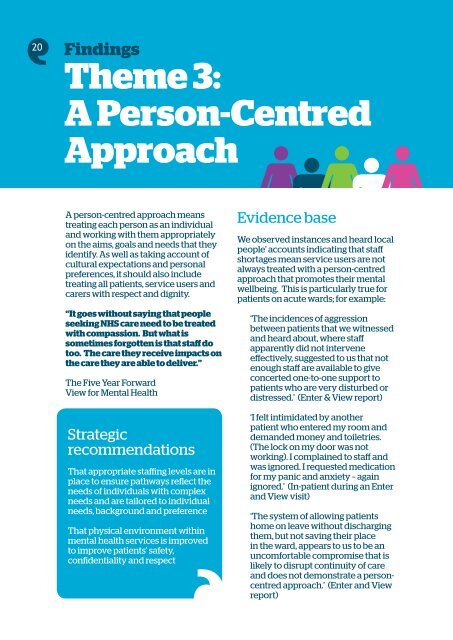Listening to_FINAL_pages
Create successful ePaper yourself
Turn your PDF publications into a flip-book with our unique Google optimized e-Paper software.
20<br />
Findings<br />
Theme 3:<br />
A Person-Centred<br />
Approach<br />
A person-centred approach means<br />
treating each person as an individual<br />
and working with them appropriately<br />
on the aims, goals and needs that they<br />
identify. As well as taking account of<br />
cultural expectations and personal<br />
preferences, it should also include<br />
treating all patients, service users and<br />
carers with respect and dignity.<br />
“It goes without saying that people<br />
seeking NHS care need <strong>to</strong> be treated<br />
with compassion. But what is<br />
sometimes forgotten is that staff do<br />
<strong>to</strong>o. The care they receive impacts on<br />
the care they are able <strong>to</strong> deliver.”<br />
The Five Year Forward<br />
View for Mental Health<br />
Strategic<br />
recommendations<br />
That appropriate staffing levels are in<br />
place <strong>to</strong> ensure pathways reflect the<br />
needs of individuals with complex<br />
needs and are tailored <strong>to</strong> individual<br />
needs, background and preference<br />
That physical environment within<br />
mental health services is improved<br />
<strong>to</strong> improve patients’ safety,<br />
confidentiality and respect<br />
Evidence base<br />
We observed instances and heard local<br />
people’ accounts indicating that staff<br />
shortages mean service users are not<br />
always treated with a person-centred<br />
approach that promotes their mental<br />
wellbeing. This is particularly true for<br />
patients on acute wards; for example:<br />
‘The incidences of aggression<br />
between patients that we witnessed<br />
and heard about, where staff<br />
apparently did not intervene<br />
effectively, suggested <strong>to</strong> us that not<br />
enough staff are available <strong>to</strong> give<br />
concerted one-<strong>to</strong>-one support <strong>to</strong><br />
patients who are very disturbed or<br />
distressed.’ (Enter & View report)<br />
‘I felt intimidated by another<br />
patient who entered my room and<br />
demanded money and <strong>to</strong>iletries.<br />
(The lock on my door was not<br />
working). I complained <strong>to</strong> staff and<br />
was ignored. I requested medication<br />
for my panic and anxiety – again<br />
ignored.’ (In-patient during an Enter<br />
and View visit)<br />
‘The system of allowing patients<br />
home on leave without discharging<br />
them, but not saving their place<br />
in the ward, appears <strong>to</strong> us <strong>to</strong> be an<br />
uncomfortable compromise that is<br />
likely <strong>to</strong> disrupt continuity of care<br />
and does not demonstrate a personcentred<br />
approach.’ (Enter and View<br />
report)


